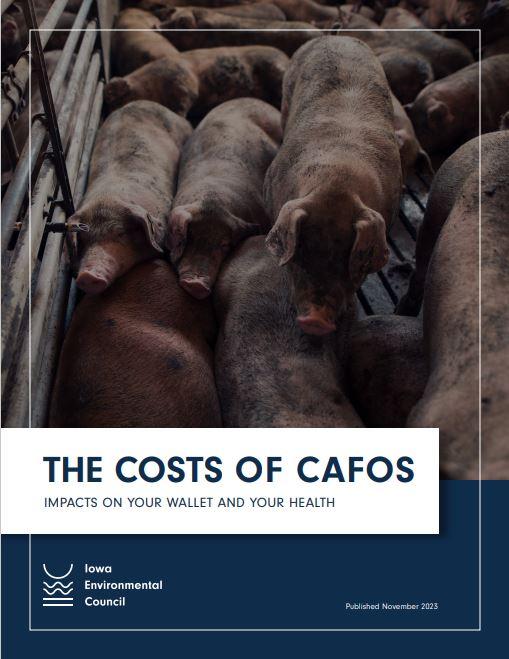
DES MOINES, IOWA (November 15, 2023) — Iowans are shelling out hundreds of millions of dollars to treat their drinking water and pay for treatment of life-threatening health-care issues caused by nitrate pollution from concentrated animal-feeding operations (CAFOs) in the state, according to a new report published today by the Iowa Environmental Council (IEC).
The report, The Costs of CAFOs: Impacts on Your Wallet and Your Health, reviews data as part of a cost-benefit analysis published for the first time by the Iowa Department of Natural Resources, the state agency that manages CAFO compliance in Iowa. The DNR compiled the cost-benefit analysis as part of the agency’s rule review mandated by Governor Kim Reynolds in January 2023.
“It’s eye-opening to see what CAFOs are really costing Iowans, beyond just operator costs or what the oversight costs the DNR. Every Iowan is paying in some way for these operations — some more than others. Even if you don’t have a CAFO in your community, you’re probably paying higher water bills as utilities struggle to reduce nitrate in your drinking water. You’re paying health-care costs as well, whether it’s direct medical bills or increasing health-care premiums as Iowa’s cancer rate increases,” said Alicia Vasto, IEC Water Program Director.

The report looked at data and reports on drinking water costs, finding that if nitrogen pollution rates do not change, Iowans will spend up to $333 million dollars on nitrogen removal in drinking-water systems the next five years. That spending weighs more heavily on rural Iowans and those in smaller communities, where individuals pay more per person for upgraded treatment systems or access to new water sources to meet the current nitrate standard of ten mg/l in drinking water.
The Iowa Cancer Registry’s 2023 report found that the state ranked second in the nation for overall cancer incidence. Iowa’s portion of cancer cases is 150% greater than its portion of the national population. That news came as a growing body of research is indicating that the nitrate standard of ten mg/l may not be protective enough of people’s health. A 2019 report by Environmental Research showed that more than 300 of Iowa’s yearly cancer cases are attributable to nitrate exposure.
“Many Iowans were shocked to learn that we are the only state in the nation facing growing cancer rates,” said Vasto. “And cancer is just one of the negative outcomes of nitrate exposure. There are a wide range of health problems linked to nitrate exposure, including birth defects, low IQ from preterm births, disability, and more.”
In addition to drinking water and health-care costs, Iowa’s economy takes a hit due to CAFO pollution. Communities that benefit from outdoor recreation can see decreased spending due to manure pollution in local lakes and streams. According to an Iowa State study, Iowans spent more than $1 billion in 2019 on day trips to lakes in-state but took 21% as many trips out of state, taking their dollars with them.

Iowa has experienced hundreds of fish kills, toxic algae blooms unsafe for humans and pets, and other poor water quality due to manure pollution. These persistent water problems drive Iowans to spend their money to fish, swim, and boat out of state rather than locally.
“Solutions to address and mitigate CAFO pollution exist, but we need regulatory change to make meaningful progress to protect public health, our local economies, and Iowa residents. Hoping for widespread change through voluntary action has proven to be costly, both in dollars and in healthy futures, and it’s time to change the expectations for these facilities to continue operating,” said Vasto.








